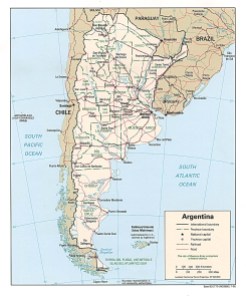For general information about the country profiles click here.
 Population: 41,086,927
Population: 41,086,927
HDI ranking: 45/187
HDI score: 0.811
In 2001, Argentina faced a major economic downturn, which forced the country to reestablish and grow its local government structures. In the past decade, the economy has been recovering at a steady pace and the political system is stronger than before (UCLG, 2008).
Local governance at a glance
- The federal state of Argentina is structured into a two-tiered sub-national government (UCLG, 2008):
- 23 provinces led by a governor, and one federal district (Buenos Aires) led by the president
- 2,252 local governments or municipalities, of which 1,151 have established additional tiers of government while 1,101 have not.
- Provinces are autonomous, organizing their own elections and constitutions, though they cannot pass laws that contradict the Constitution and federal laws. Some provinces have bicameral provincial legislatures, while others have unicameral ones (Argentina Constitution).
Civil society actors include
- Equipo LatinoAmericano de Justicia y Género (ELA) works to promote the exercise of women’s rights and to establish fair laws that incorporate the best interests of both women and men.
- Argentine Network for International Cooperation is composed of 74 civil society organizations, and the network aims to promote conversation and create a space for information exchange.
Capacity building institutions
- The Federación Argentina de Municipios (FAM) works to improve the quality of municipal public management through training on topics ranging from e-government to decentralization.
Fiscal control
- In the 1990s, risky financial behavior by subnational governments spurred a period of hyperinflation and economic instability. The Law of Economic Emergency of 2002 and the Budget Law of 2006 gave the central government increased discretion in transferring federal funds or unilaterally interrupting disbursement (UCLG, 2010).
- The federal government transfers around 7-10% of overall GDP to local municipalities, comprising nearly half of the central government’s expenditures (IDB, 2012).
- Local governments receive a portion of the taxes collected by their province.
- Nearly 50 percent of local expenditures are from own-source taxes and fees (UCLG, 2010). Sales tax and real estate tax are the most prominent contributors to local government’s revenue (IDB, 2011).
Key Initiatives for participatory local governance
- Since 1983 when democracy returned to Argentina, national and local voting levels have remained around 80 percent (UCLG, 2008).
- Instead of enumerating the fiscal powers of local government in the Constitution, Argentina gives provinces, the intermediate level government, discretion to structure fiscal arrangements directly with the municipalities (UCLG, 2010).
- Several provinces in Argentina have adopted a form of participatory budgeting (UCLG, 2010).
Challenges for participatory local governance
- According to a 2008 report from the United Cities and Local Governments, there is a disparity among municipalities due to the fact that a majority of the local government seats are representing small communities with less than 10,000 citizens. Therefore, representation is skewed toward the country’s population that resides in small municipalities (UCLG, 2008).
- The Federal Council for Fiscal Responsibility (created by the Fiscal Responsibility Law of 2004) is in charge of monitoring compliance with norms and rules of fiscal and financial behavior, but does not receive timely information from the majority municipalities (UCLG, 2010).
Recent posts on this website about this country:
- Participation for what : social change or social control? (2010)
- Local governance in developing countries (2006)
- Decentralization, democratization, and liberalization : the history of revenue sharing in Argentina, 1934-1999 (2000)
List of sources (in order of citation)
UN Human Development Index, 2012: “Argentina”
UCLG, 2008 : “Argentina”
Inter-American Develoment Bank (UNLP), 2011 “Argentina. Are Vertical Transfers Deteriorating Sub-national Governments Revenue Effort?”
Inter-American Development Bank, 2012: “Sub-National Revenue Mobilization in Latin American and Caribbean Countries: The case of Argentina”
UCLG, 2010: “Local Government Finance: The Challenges of the 21st Century”
UN ECLAC, 2011: “Macroeconomic challenges of fiscal decentralization in Latin America in the aftermath of the global financial crisis”
